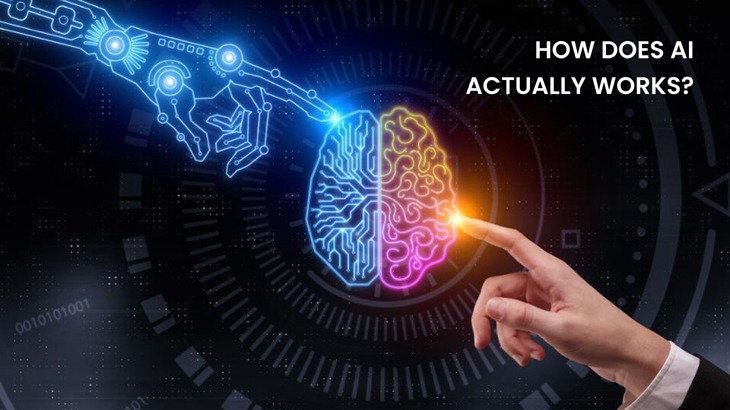Artificial Intelligence (AI) is the capacity of any machine to carry out operations frequently performed by intelligent beings. The phrase is widely used to create artificial intelligence (AI) systems that possess human-like cognitive abilities like the capacity for reasoning, meaning-finding, generalization, and experience-based learning.
It has been proven that computers can be programmed to perform highly complicated tasks—for example, finding proofs for mathematical theorems or playing chess—with remarkable proficiency ever since the development of digital computers in the 1940s.
Working of Artificial Intelligence (AI)
How Does AI Actually Work? Artificial Intelligence works with the help of large data sets combined with cognitive, iterative processing algorithms. This is to create systems that can learn from patterns and features in the data they study. Because AI is capable of all these tasks, it has grown vital to contemporary businesses and other organizations.
Types of Artificial Intelligence (AI)
AI can be classified into four major types. They are:
Reactive Machines
A Reactive Machine is a type of AI that is entirely reactive; it cannot create "memories" or draw upon "previous experiences" to guide decision-making. These devices are made to carry out particular duties. For instance, programmable coffee makers and washing machines are made to carry out specific tasks but lack memory.
Limited Memory AI
Limited Memory makes decisions based on recent data and past experiences. Memory constraints prevent the machines from developing novel concepts. They execute the memory through an internal program. Changes are made to these machines through reprogramming. Autonomous vehicles with limited memory are an example.
Theory of Mind
These AI computers can interact with people, comprehend human emotions, and will be able to cognitively comprehend someone based on their surroundings, facial features, etc. This kind of AI is the subject of extensive research. These powers have yet to be developed in machines.
Self-Awareness
The future of AI is with Self Awareness. They will be very intelligent, sentient, and conscious machines. Despite having their unique characteristics, they can react very much like a human. Your grasp of how to create AI will improve after reading the following section of this tutorial.
Functions and Need for Artificial Intelligence (AI)
What Actually Is Artificial Intelligence? A technology with the potential to change the world is artificial intelligence. Computer software used to simulate certain features of human intelligence is known as artificial intelligence or AI.
For instance, a program that suggests books to read based on the books you've purchased or a robot vacuum with a fundamental understanding of its surroundings. It might improve human intelligence, manage autonomous vehicles, and treat cancer. Or it might bring about the extinction of humans and the robot apocalypse.
What is AI Really Doing? An AI system tests and evaluates its performance after each round of data processing to improve. Because AI doesn't require breaks, it can do hundreds, thousands, or even millions of tasks very quickly, quickly picking up a lot of knowledge and excelling at whatever work it is trained to complete.
Here is the answer to the question What is AI Really Doing? The key is to grasp that AI isn't just a particular computer program or application but an entire discipline or science. AI science aims to build a computer system that can simulate human behavior and employ human-like reasoning to solve complicated issues.
How Does Artificial Intelligence (AI) Actually Work?
Business operations in a variety of industries, including marketing, healthcare, financial services, and more, are being redefined by AI.
It makes sense for professionals to become knowledgeable in AI as the desire to enhance current procedures continues to increase. Businesses are constantly looking for new ways to benefit from this technology. AI systems use diverse technologies and a long list of methods and procedures to achieve this goal.
Basic Applications of Artificial Intelligence (AI)
1. The automatic switching of appliances at home is a typical application of AI that we see nowadays. This is an illustration of a machine without memory.
2. Some more sophisticated AI programs can estimate consumption patterns and activate appliances without explicit input.
3. Some artificial intelligence algorithms can recognize your voice and respond appropriately.
4. The TV will turn on when you command it using its sound sensors. You can do this daily with a Google Home Mini and a dongle.
Major Applications of Artificial Intelligence (AI)
Machine Learning
An application of AI that enables computer systems, programs, or apps to automatically learn and improve their performance over time without being explicitly programmed to do so. AI is now equipped to use machine learning to identify patterns in data, unearth new information, and enhance the outcomes of any work it has been given.
Deep Learning
A particular kind of machine learning that enables AI to develop and learn by handling data. Deep Learning processes information, identifies relationships between the data and generates conclusions or outcomes based on positive and negative reinforcement using artificial neural networks that resemble biological neural networks in the human brain.
Neural Networks
Artificial Intelligence (AI) systems can process vast amounts of data, find patterns among them, and respond to questions using neural networks, which function similarly to the networks of neurons in the human brain. An approach to finding correlations and deriving meaning from undefined facts by repeatedly analyzing data sets.
Natural Language Processing
A crucial step in the AI process that enables computers to recognize, examine, comprehend, and understand spoken and written human language. Any AI-driven system that interacts with humans in a manner, whether through text or spoken inputs, needs to have a strong understanding of natural language processing.
Computer Vision
Reviewing and interpreting the content of an image using deep learning and pattern recognition is one of the many applications of AI technology. Like the captchas you'll find all over the web that learns by asking humans to help them identify automobiles, crosswalks, bicycles, mountains, etc., computer vision enables AI systems to recognize components of visual input.
History of Artificial Intelligence
Some forms of artificial intelligence have been established for more than 50 years. Still, in recent years, significant progress in AI has been made thanks to improvements in processing power, the accessibility of vast amounts of data, and novel algorithms. The digital transformation of society is viewed as being centered around artificial intelligence. Although AI is prevalent daily, future applications are predicted to bring significant changes.
Examples of Artificial Intelligence in Day to Day life
Online Shopping and Advertising
Personalized suggestions are frequently given to users using artificial intelligence, for instance, based on their prior searches, purchases, or other online behavior. AI is crucial to business since it can optimize products and arrange transportation and inventory.
Web search
Search engines use many data people provide as an input to learn how to deliver appropriate search results.
Digital personal assistants
Smartphones use AI to deliver as relevant and individualized services as feasible. Virtual helpers are becoming commonplace, answering inquiries, making suggestions, and organizing everyday tasks. Ohai's AI digital assistant is another example of how these tools can simplify routines and provide tailored support in daily life.
Machine Translations
Artificial intelligence is used by text-based or spoken language translation software to provide and enhance translations. This also holds for features like automatic subtitling.
Smart Homes, Cities, and Infrastructure
Smart thermostats learn from our habits to reduce energy use, and smart city planners seek to control traffic to enhance connectivity and lessen gridlock.
Cars
Although self-driving cars are not yet standard, they already have safety features that AI powers. For instance, the EU has contributed to funding VI-DAS, automated sensors that can spot potential accidents and risky circumstances. AI is widely used to power navigation.
Cybersecurity
AI systems can help recognize and fight cyberattacks and other cyber threats based on the continuous input of data, identifying patterns, and backtracking the attacks.
Artificial intelligence against Covid-19
In the case of Covid-19, AI has been used in thermal imaging in airports and elsewhere. In medicine, it can help recognize infection from computerized tomography lung scans. It has also been used to provide data to track the spread of the disease.
Fighting Disinformation
Specific AI applications can detect fake news and disinformation by mining social media information, looking for sensational or alarming words, and identifying which online sources are authoritative.














Post Comments